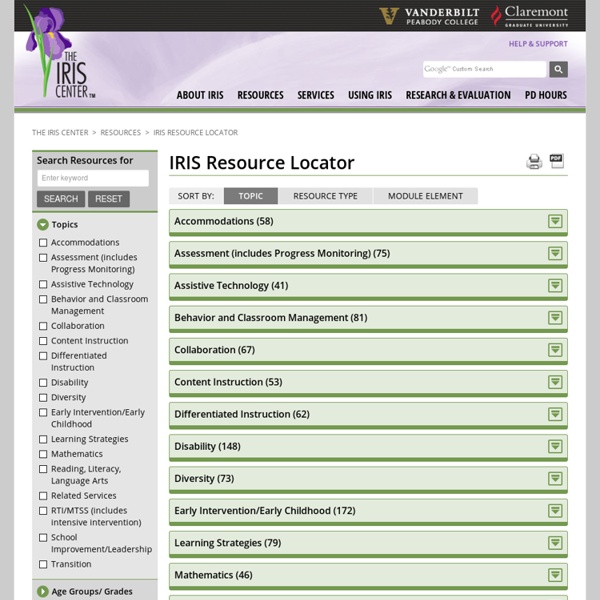College Quarterly - Articles - Managing Disruptive Behaviour in the Classroom
College Quarterly Summer 2011 - Volume 14 Number 3 Managing Disruptive Behaviour in the Classroom By Catherine Deering, Ph.D. Abstract Both faculty and students at many colleges and universities report numerous incidents of disruptive and uncivil behaviour.
Classroom Assessment
The values for reliability coefficients range from 0 to 1.0. A coefficient of 0 means no reliability and 1.0 means perfect reliability. Since all tests have some error, reliability coefficients never reach 1.0. Generally, if the reliability of a standardized test is above .80, it is said to have very good reliability; if it is below .50, it would not be considered a very reliable test. Validity refers to the accuracy of an assessment -- whether or not it measures what it is supposed to measure. Even if a test is reliable, it may not provide a valid measure.
Knowledge, Creativity and Innovation by David Gurteen
First published in the Journal of Knowledge Management Volume 2, Number 1, September 1998 Creativity and innovation concern the process of creating and applying new knowledge. As such they are at the very heart of knowledge management.
Education Support Partnership – supporting you to feel your best
Disruptive pupil behaviour is a frustration for many teachers. In fact, 70% of teachers told us they had considered quitting the profession over poor behaviour. (Teacher Support Network and Family Lives Behaviour survey 2010) Poor behaviour is a barrier to learning and can easily threaten the health and wellbeing of teachers. On top of other pressures that can occur, the result is lost teaching days, unhappy teachers and failing students.
4 Ways To Amplify Your Creativity
The holidays are over, the weather is lousy, and we’re sober again. We made all kinds of New Year’s promises, but the big one that will change our careers, if not our lives, is the promise to ourselves to become more creative. In my new book, Creative Intelligence, I show that creativity is learned behavior that gets better with training--like sports.
Better Classes Improve Behavior of Special Needs Kids
Updated January 14, 2016. Inappropriate curriculum and instruction can lead to many types of problem behaviors in students with learning disabilities, while the right classes may prevent special needs children from acting out. Determine if there's a link between a special needs child's behavior problems and her classwork, with this overview.
The Power of Project Learning
By Wayne D'Orio Here’s a riddle: Imagine there is a learning technique proven effective through 100 years of use that is now enhanced by the power of today’s technology. Imagine it can excite learners to continue their work well past the parameters of the school day. What is it, and would every school in the country do it? It is project-based learning, and the answer is yes, and no. Project-based learning can be traced back to John Dewey and it has come and gone since the early 20th century.
Exercise: An Antidote for Behavioral Issues in Students?
MONDAY, Jan. 9, 2017 (HealthDay News) -- Children with serious behavioral disorders might fare better at school if they get some exercise during the day, a new study suggests. The researchers focused on children and teenagers with conditions that included autism spectrum disorders, attention deficit hyperactivity disorder (ADHD), anxiety and depression. They looked at whether structured exercise during the school day -- in the form of stationary "cybercycles" -- could help ease students' behavioral issues in the classroom. Over a period of seven weeks, the study found it did.
Third Grade Health Adventure
Have you ever heard the expression "You are what you eat!"? When people say that they don't mean that eating a hamburger will actually make you turn into a hamburger. They mean that your food choices affect your health and how well your body functions. If you make unhealthy food choices, your body will not be as healthy as it should be and it will not function as well as it could.
Understanding Inquiry in Health and Physical Education
What is Inquiry-Based Learning “Inquiry-based learning is a process where students are involved in their learning, formulating questions, investigate widely and then build new understandings, meanings and knowledge. That knowledge is new to the students and may be used to answer a question, to develop a solution or to support a position or point of view.
Solving Wicked Problems
1. How can we design meaningful learning experiences that support studnet problem solving? Though we often emphasize the importance of problem centered learning environments, it is hard to find a comprehensive approach to designing such environments.
Open source textbook publisher projects $1M in savings
OpenStax has been well received on college campuses as textbook prices remain stubbornly high By Dennis Carter, Assistant EditorRead more by Denny Carter August 14th, 2012 Educators at 55 colleges will use OpenStax books this fall. College students in some of the most heavily attended courses in the country will eclipse $1 million in textbook savings after a Rice University-based publisher had 13,000 open-source books downloaded since June. OpenStax College, a start-up online textbook publisher launched early this year, announced Aug. 14 that its first two book titles, College Physics and Introduction to Sociology, have sold more than 13,000 free copies – enough to save students $1 million during the upcoming fall semester.
KSU Professor Developing ‘Flexbooks,’ The Textbook Of The Future
There’s a new term you should add to your vocabulary. It’s ‘flexbooks’ and a Kansas State University assistant professor is hoping they change the way you teach. Click here to view an actual flexbook used at Kansas State University. E-textbooks are nothing new, neither are digital publications that you can actually update. Places like Academic Pub , Kno , and CourseSmart (amongst many others) all offer options but the term flexbooks is completely new. I kinda like it.



